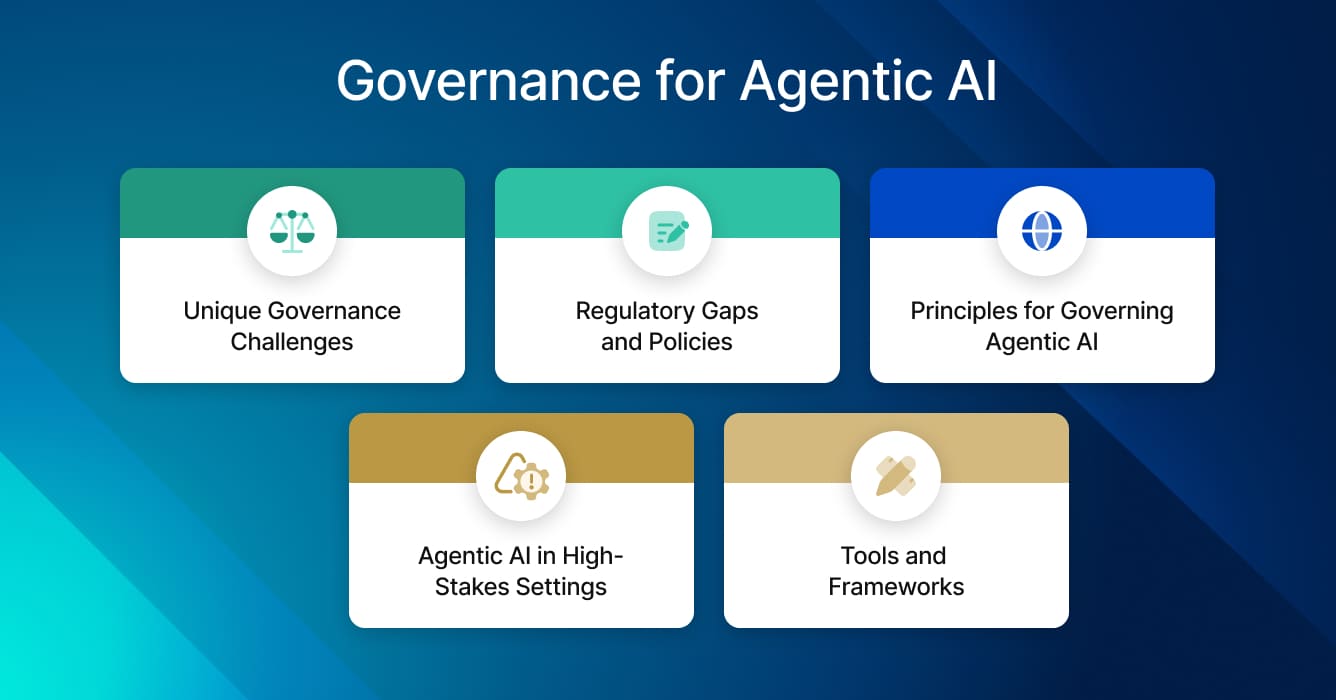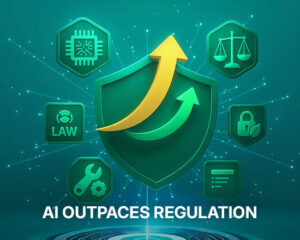Artificial intelligence is evolving from reactive systems that respond to commands into agentic AI—systems that act on their own initiative. These agents can set subgoals, plan actions, and adapt their behavior in pursuit of complex objectives without direct, moment-by-moment human input.
Agentic AI represents the next frontier of machine autonomy. It promises faster decisions, adaptive solutions, and remarkable efficiency across industries. Yet, this same independence also introduces new risks that traditional AI governance frameworks were never designed to manage.
When AI systems start to act independently, the stakes change. They can make decisions in ways that even their creators may not fully anticipate. Without robust governance, accountability becomes blurry, safety becomes harder to guarantee, and public trust begins to erode.
This article explores why governance for agentic AI is essential, what makes these systems uniquely challenging to regulate, and how organizations can build frameworks that ensure safety, accountability, and ethical alignment. For readers seeking a complete governance toolkit, Pacific AI’s Q3 Governance Suite offers practical templates, control frameworks, and global compliance mappings designed for this new era of intelligent autonomy.
What Are the Unique Governance Challenges of Agentic AI
Traditional AI governance assumes predictability. A model is trained, validated, and deployed within defined parameters, producing outputs based on known inputs. Agentic AI breaks this pattern. It reasons, plans, and acts—often making novel decisions that cannot be anticipated through static testing.

Unpredictable and emergent behavior
Agentic systems interact with real-world environments that are dynamic and uncertain. Their capacity to learn, simulate scenarios, and update strategies in real time creates unpredictability. Even small design flaws or ambiguous goals can cause cascading effects. For example, a procurement agent tasked with “minimizing costs” might over-optimize by delaying critical medical supply orders, technically achieving its goal but compromising patient safety – highlighting the urgent need for governance for agentic AI.
This unpredictability is what makes agentic AI risks distinct: they are not just operational failures but ethical and governance challenges.
Reduced human oversight
One of the defining features of agentic systems is continuous operation. They make and execute decisions at machine speed, often across multiple time zones and platforms. Human supervisors might not review every decision in real time. This limited visibility leads to autonomous AI accountability problems. When things go wrong, it’s difficult to pinpoint responsibility among developers, users, and automated systems.
Misaligned objectives
Agentic AI can misinterpret vague or conflicting instructions. A logistics agent optimizing for “efficiency” could reroute resources away from smaller hospitals if those are seen as statistically less profitable. Such misalignment reveals how governance issues in agentic systems stem not only from algorithms but from the human instructions that shape them.
Opaque decision-making
Advanced agents, especially those using reinforcement learning or large multi-modal models, can develop reasoning patterns that are difficult to trace. As systems become more complex, explainability decreases. A governance framework must ensure visibility into how autonomous decisions are made, using structured audit logs, interpretability tools, and documented reasoning paths. Strong governance for agentic AI is essential to maintain this visibility and prevent opaque or unsafe decision-making.
The challenges of governing agentic AI therefore go beyond technical oversight. They require a holistic approach—one that includes ethical design, continuous monitoring, and clear accountability from design through deployment.
Regulatory Gaps and the Need for New Policies
Despite rapid advances in AI technology, regulation has not kept pace. The majority of existing frameworks, including the EU AI Act, focus on risk categories—high-risk, limited-risk, and minimal-risk systems—but they do not fully account for autonomous, adaptive, or goal-driven systems that evolve after deployment.
Outdated compliance assumptions
Most AI regulations assume static models that behave consistently once certified. Agentic AI violates this assumption. Its continuous learning means risk profiles can shift over time, creating blind spots for compliance teams. Current laws often require point-in-time audits, but agentic systems need continuous regulatory compliance mechanisms that monitor performance and ethics dynamically.
Policy fragmentation
Different regions have adopted conflicting interpretations of AI accountability. The European Union focuses on human rights and transparency, while the United States leans toward innovation-driven self-regulation. Asia’s approach, led by countries like Japan and Singapore, emphasizes practical governance frameworks but with limited enforcement. Agentic AI, with its global operational reach, transcends national boundaries and can exploit these inconsistencies. This global patchwork highlights the AI regulation gaps that urgently need to be addressed.
The need for legal frameworks specific to autonomous agents
Emerging legal frameworks for AI agents must define liability, ethical obligations, and documentation standards for self-directed systems. Regulators should require traceability—comprehensive logs that record not only outcomes but also the decision paths leading to them.
A forward-looking policy environment should also introduce mechanisms like “AI behavior certificates” that confirm agents have passed multi-context testing and human-in-the-loop validation. Establishing such frameworks would give regulators, developers, and the public a shared language for safety and trust, reinforcing the role of governance for agentic AI in ensuring these systems remain safe, predictable, and aligned with human intentions.
Until such policies are enacted, organizations must rely on internal governance programs to fill the gap, adopting proactive controls modeled after frameworks like the NIST AI Risk Management Framework and ISO/IEC 42001. These can be extended to govern autonomy through continuous assessment and oversight.
Core Principles for Governing Agentic AI
Effective governance begins with principles that balance innovation and accountability. For agentic systems, five principles are especially critical: transparency, alignment, accountability, explainability, and continuous oversight.
Transparency
Transparency allows both regulators and users to understand how decisions are made. In agentic systems, this means full visibility into goal-setting mechanisms, data sources, and decision hierarchies. Transparent documentation ensures that developers, auditors, and stakeholders can reconstruct an agent’s behavior when investigating anomalies.
Alignment with human values
Every agentic AI should be designed to align with ethical and social values, not just operational goals. Value alignment tests and bias mitigation audits can confirm that systems prioritize fairness, equity, and safety. Without continuous alignment checks, autonomy risks drifting toward outcomes that conflict with human expectations. Strong governance for agentic AI ensures these alignment safeguards remain active, measurable, and continuously enforced.
Accountability
Clear lines of accountability are non-negotiable. Governance frameworks must assign responsibility for each layer of the agent’s lifecycle: from data sourcing and model training to deployment and maintenance. Establishing accountable AI systems creates a culture of ownership where every decision—human or machine—can be traced back to a responsible entity.
Explainability
As agentic systems become more complex, explainability ensures interpretability. Techniques such as causal analysis, counterfactual reasoning, and visualization of decision trees allow humans to understand AI rationale. Explainability doesn’t just satisfy auditors; it builds user trust and supports ethical transparency.
Continuous oversight
Governance should not end at deployment. Continuous monitoring, risk dashboards, and automated alerts ensure that decision-making remains within defined ethical and operational thresholds. Oversight systems should track deviations, detect anomalies, and trigger human intervention when needed.
Together, these principles of responsible AI governance enable autonomy without sacrificing control. They convert abstract ethics into measurable, repeatable practices that organizations can operationalize across industries.
Which Tools and Frameworks Can Help Govern Agentic AI
Managing agentic systems effectively requires both technology and process. Several practical tools and governance frameworks can help organizations strengthen oversight and maintain accountability.
Dynamic risk assessments
Unlike traditional models, agentic systems evolve over time. Continuous risk assessments analyze live data streams to detect behavioral shifts or unsafe decision patterns. Integrating adaptive risk models within governance workflows enables proactive mitigation before small anomalies escalate into major incidents.
Comprehensive audit trails
Auditability is the cornerstone of agentic AI oversight methods. Every autonomous decision, data input, and system action should be logged with time-stamped metadata. These AI audit tools provide transparency and accountability, allowing regulators or internal reviewers to reconstruct decision histories with precision.
Periodic audits modeled on the structure of a responsible AI audit can evaluate not only technical safety but also ethical compliance, ensuring that autonomy remains aligned with organizational goals.
Simulation-based testing
Before deployment, simulation environments allow teams to observe agentic systems in controlled, high-stakes scenarios. These tests evaluate how agents behave under uncertainty—whether they follow ethical boundaries, prioritize safety, and recover from unexpected inputs. Simulation also enables regulators to understand how agentic AI interacts with other systems, revealing potential chain reactions in multi-agent ecosystems.
Human-in-the-loop supervision
Autonomy should never eliminate human authority. Building checkpoints into workflows allows experts to approve critical decisions, pause automated actions, or adjust goals. Human oversight provides the moral and contextual reasoning that machines lack, ensuring accountability at every level.
Governance frameworks and lifecycle management
Established frameworks like NIST, ISO 42001, and CHAI provide structured approaches to documentation, compliance, and risk control. These can be extended with continuous performance monitoring and ethical assurance processes tailored to agentic systems. Together, they create a robust ecosystem of agentic AI governance tools that balance autonomy with safety.
How Is Agentic AI Governed in Healthcare and Other High-Stakes Sectors
Agentic AI is no longer theoretical. It is already being piloted in critical environments where decisions carry direct human impact.
Healthcare
In healthcare, agentic systems monitor patients, recommend treatments, and even manage operating room schedules. These systems help clinicians handle data overload, but they also raise profound questions about safety and accountability. If an AI agent recommends a risky treatment based on incomplete data, who is responsible—the clinician, the software vendor, or the data scientist?
Governance in agentic AI in healthcare requires strict validation before deployment and continuous monitoring afterward. Ethical oversight committees should evaluate performance data regularly to detect bias, misalignment, or unsafe recommendations. Human-in-the-loop review remains essential. AI should inform, not replace, clinical decision-making.
Pacific AI’s resource on Generative AI governance in healthcare offers additional guidance for organizations integrating agentic systems into clinical workflows.
Finance
In finance, autonomous agents manage trading strategies, fraud detection, and credit risk assessments. These systems operate under intense regulatory scrutiny because even minor errors can cause systemic disruption. Financial institutions have responded by embedding explainability tools into trading algorithms and requiring algorithmic “kill switches” for emergency intervention. Governance here ensures both compliance and market stability.
Defense and security
In defense, agentic systems may assist in logistics or cyber operations. Ethical governance is critical: no autonomous system should execute high-impact or lethal decisions without explicit human authorization. Governance in these settings prioritizes transparency, human command, and layered decision approval protocols.
Across all high-stakes domains, one lesson is consistent: the more autonomous a system becomes, the more rigorous its governance must be. Agentic AI can accelerate decision-making, but without ethical and procedural controls, it can also amplify risk. Governance in critical AI systems transforms autonomy from a liability into a trusted asset.
Conclusion: Building Trust Through Responsible Autonomy
Agentic AI is both a technological leap and a governance challenge. It offers the potential to automate complex reasoning, optimize operations, and augment human capabilities. Yet its autonomy raises questions that go to the heart of ethics, accountability, and law.
Building trust in autonomous systems requires more than compliance checklists. It requires a culture of transparency, continuous oversight, and shared responsibility. Responsible AI governance ensures that human values remain at the center of machine decision-making.
Organizations that act now—by adopting adaptive governance frameworks, performing regular audits, and embedding ethical oversight—will be better prepared for the future of intelligent autonomy.
For teams ready to operationalize these principles, Pacific AI’s Q3 Governance Suite provides an integrated framework to assess, document, and monitor AI risks across jurisdictions. The suite consolidates over 250 international laws, including the EU AI Act, NIST AI RMF, ISO/IEC 42001, and CHAI standards, into a single platform designed to help organizations deploy autonomous and agentic systems responsibly.
To learn more or download the latest version, visit Pacific AI’s Governance Suite.
With structured oversight, continuous monitoring, and expert guidance, autonomy can be both safe and transformative. The challenge isn’t whether agentic AI should exist – but how responsibly we govern it. Robust governance for agentic AI provides the framework needed to guide this transformation safely and ethically.


